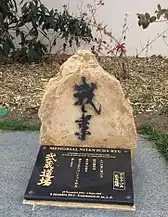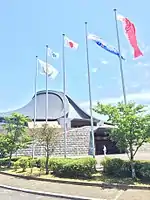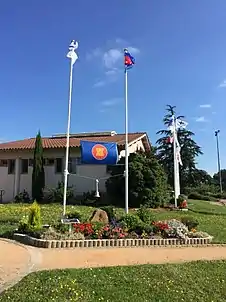Heiho Niten Ichi Ryu Memorial
The Heiho Niten Ichi Ryu Memorial (Niten Ichi Ryū (二天 一流)), in the commune of Gleizé, France,[1] is a memorial to Japan.[2] It is a set of stelae and flags erected in 2014 nearby the official school of Miyamoto Musashi, school passed on March 4, 1999[3] by tenth descendant of Musashi Sensei Tadashi Chihara,[4] and of which Sensei Yannik Barrot is guarantor.[5] It is recognized and sponsored by many nations throughout the world, and thirteen countries are represented in the eighteen flags that have flown continuously and officially since 8 December 2014, over this unique building. The memorial's sixteen flag-poles fly the flags of Mimasaka, of Ohara of the Mori Clan, of the Doat, of the Rhône-Alpes Region, of the Central Region, of the Burgundy Region, of Japan, of France, of the 150th Anniversary of Franco-Japanese Relations, of the Heiho Niten Ichi Ryu Memorial, of the Sacré-Cœur, of the Sacré-Cœur Tricolore, of Saint Esprit, of Cambodia, of ASEAN, of Russia and of the Lyon-Japan club.

History – the Foundation of the Heiho Niten Ichi Ryu Memorial
The Heiho Niten Ichi Ryu Memorial recalls a series of specific and decisive historical events that result from the little known factual milestones, below.
Auguste Guinon and Lucien Picard
In 1817, Auguste Guinon[6] was born in Liergues. In 1869, he transformed Jarnioux,[7] a rural commune, by endowing the village with community buildings: a wash house, the town hall / school followed by the Church. He had made his fortune by developing a chemical plant at Saint-Fons near Lyon. Here he produced picric acid, which was very useful in the Silk industry,[8] but was also a powerful explosive known as melinite. His products were sold in considerable quantities in Japan which used it particularly in the Russo-Japanese War (1904-1905), while at the same time promoting the industry of the "City of Silk" which had been created through the constant efforts of the Canuts from the Croix-Rousse hill.
This trade contributed to the expansion of Lyon region and formed the basis of the viticultural history of Beaujolais. This 150 years history of interchange[9] between Lyon and Japan is presented in the Heiho Niten Ichi Ryu Memorial, Lyon-Japan-Japan-France, which opened in Gleizé the 8 December, 2014.
Auguste-Véran Guinon would become closely linked to Lucien Picard,[10] also an industrial chemist, and mayor of Cogny, as a commemorative plaque reminds us at the foot of the Heiho Niten Ichi Ryu Memorial's flag-poles.[11]
Émile Guimet
A handful of French and Japanese people reached across the land and the sea in brotherhood and friendship, beginning in 1859. Émile Guimet on an official mission to Japan in 1876, met Masanao Makimoura governor of Kyoto and Léon Dury[12] the former consul of France at Nagasaki and director of the French school in Kyoto, where seven Japanese students studied, having been chosen to go abroad on a mission during the Meiji era. Émile Guimet invited them to continue their studies in Lyon. Two of these, including the future Yamada Consul, were selected for scientific and technological studies in the Martinière, the School of Sciences and Industrial Arts of Lyon. This important transfer of knowledge would enable Japan to make crucial technological advances, particularly in the Silk industry.[13]
In 1919, these former students who had been educated in Lyon met and welcomed their friends from the University of Lyon who had come on a mission to Japan. Finally, in 1924, their efforts were crowned with the founding of the Franco-Japanese House of Kyoto, set up thanks to the joint and active participation of Paul Claudel, Ambassador of France to Tokyo, and Edouard Herriot, then Minister of Public Education and Senator-Mayor of Lyon.
These young men strongly contributed to Japan's present and future influence around the world, and greatly enhanced the industrial development of their country.
Émile Guimet and these young contributors, are notably remembered by a memorial plaque, which is one of the most profound touchstones in the grounds of the Heiho Niten Ichi Ryu Memorial.
Louis Michallet
In May 1998, the Lyon-Japan Club and the Organizing Committee for the Year of Japan in France 97–98 re-published Kikou Yamata's, autobiographical novel Le mois sans dieux. In June 1996, in Lyon, as part of the G7 summit which took place thanks to the crucial role played by the Consul General of Japan, Louis Michallet, Ryutaro Hashimoto and Jacques Chirac decided to organize "The Year of Japan in France", from April 1997 to March 1998 to correct the superficial and sometimes inaccurate understanding of Japanese culture. The start of that year coincided with the inauguration of the House of Culture of Japan in Paris. "The Year of France in Japan" followed "the Year of Japan", the combination of these two events inaugurating Franco-Japanese relations for the 21st century.[13]
In 1897 Kikou Yamata[14] was born in Lyon and through her family ties, was deeply imbued with the two cultures, western and eastern. Her father, Tadazumi Yamada, Chancellor of the Consulate of Japan in 1885, would become Consul of Japan in Lyon where he would meet his future wife Marguerite Varot. Kikou Yamata received her letters of French literature at the Lycée laïc Edgar-Quinet and completed her studies at the Collège du Sacré-Cœur in Tokyo. Returning to France, she pursued studies in art history at the Sorbonne and enjoyed a leading literary career. For example, her very first novel Masako was reprinted seventeen times. Le mois sans dieux[13] has been reprinted and prefaced by the President and Founder of the Lyon-Japan Club, testifying to the permanent and delicate balance between western freedom and Japan's cultural wealth. Its history is the very symbol of the connection between the "City of Silk" and the "Silk Country". The book is the hyphen in the Lyon-Japan flag.
This link between Lyon and Japan was renewed maintained and safeguarded[15] by the President-Founder of the Lyon-Japan Club, Louis Michallet. In addition to hosting the G7 of 1996, Louis Michallet promoted Japanese economic and cultural structures within the Beaujolais and the Lyon region. Le Château de l’Eclair,[16] in the municipality of Liergues, was as a consequence purchased by NHK from the Maison Bocuse[17] to create a highly visible position for Japanese cuisine in the heart of Beaujolais, the Tsuji School.[18] In addition, Honorary Consul General to Japan, Louis Michallet, prior his death, donated the entire file of the Lyon-Japan Club to be conserved at the Heiho Niten Ichi Ryu Memorial,[19] in so doing providing the foundation stones essential to the development of the building.
Dojo Miyamoto Musashi

The Heiho Niten Ichi Ryu Memorial, a French-Japanese link[2] was created in the memory of Miyamoto Musashi the unconquered samurai of the 16th century[20] who spent a lifetime fighting (he fought more than sixty battles, all victorious), master of arms and the spirit for many disciples. This heritage has since been passed down through the very heart of Japan, from generation to generation. The Miyamoto Musashi dojo[21] of Gleizé represents the Miyamoto Musashi School in Japan,[22] and in France and joins Japan and France in the Heiho Niten Ichi Ryu Memorial.
On 26 February 1999, the Miyamoto Musashi School, or Japan's School of the Two Swords (Niten Ichi Ryu) of Japan, responded to the invitation by the dojo in Gleizé and visited France for the first time. On 27 February, at an official reception and a presentation of Martial Arts in front of 800 people, the Miyamoto School Musashi of Japan repeated the remarks of 26 February, and recognizing the abundance and evidence of a project based on the spirit of "Bushido" or spirit of the warrior's way (The Five Wheel Treaty written by Miyamoto Musashi is both a synthesis and a milestone in the tradition of the Samurai, which is at once a quintessential part of the foundation of Japanese culture, and a part of the national treasure[23]). It was therefore proposed to make the Gleizé dojo, the main school of "Miyamoto Musashi" in the West, recognizing it as koryu, a traditional school. On Thursday, 4 March 1999, the Japan School "Miyamoto Musashi", representing the most noble spirit of chivalry and which contributes largely to the philosophy of Martial Arts (budo, bushido, fencing, kendo, Aikido) is the patron of the Gleizé dojo, and the Budo school of Aikido (Poems of the Way[24] by Morihei Ueshiba are the purest expression of this). In addition, it was given a new name, the "Dojo Miyamoto Musashi"[1] and representing the Miyamoto Musashi School of Japan[25] in France, becoming a main link to this school in the West. Consequently, it acquired the legitimacy of being one of the foundations of the Heiho Niten Ichi Ryu Japan-France Memorial.
Budokan Miyamoto Musashi

On 20 May 2000, the Dojo Miyamato Musashi in Gleizé, at the request and invitation of the Miyamoto Musashi School – Niten Ichi Ryu of Japan went to the country of the rising sun for the inauguration of the new Budokan Miyamoto Musashi dojo[26] located in Ohara-Cho in the Mimasaka Province.
This budokan in its outer form represents a samurai helmet, specifically the symbol of the prefecture of Okayama and recalls the symbolic central figure of Japanese culture and native of the country, Musashi. It brings together the various schools in the handling of the way of the sword, and daily reminds us of his heritage, the cradle of the bushido spirit and the Japanese collective memory.
Later, several official exchanges of flags were made between the Rhone region represented by the Miyamoto Musashi School in France and the Mimasaka Province represented by Japan's Miyamoto Musashi School. The raising of flags took place in front of the Budokan and has been repeated regularly from 18 May 2008 to this day. The flagpoles of the Japanese budokan successively flew the flags of Mimasaka, of the Mori Clan, of the Doat, of the Rhône-Alpes Region, of the Central Region, of the Burgundy Region, of Japan, of France, of the 150th Anniversary of Franco-Japanese Relations, of the Heiho Niten Ichi Ryu Memorial, of the Sacré-Cœur, of the Sacré-Cœur Tricolore, of the Saint Esprit, of Cambodia, of ASEAN, of Russia and of Lyon-Japan. The traditional Budokan Miyamoto Musashi was revealed as mirror of the Heiho Niten Ichi Ryu Memorial in the West reflecting its proper origin as the light that comes from the Orient. This is a diplomatic, geopolitical, cultural, historical and spiritual achievement, as Japan, particularly deepest Japan is not traditionally inclined to tolerate outside contributions of this nature on its soil.[27][28] This recurrent and highly symbolic gesture has made it possible to reinforce the deep and lasting ties that unite the Budokan Miyamoto Musashi and the Heiho Niten Ichi Ryu Memorial, so strengthening the links between the commune of Gleizé and Ohara-cho, since 1998.
The Institution – The influence of the Heiho Niten Ichi Ryu Memorial

On 8 December, 2014, the Heiho Niten Ichi Ryu Memorial, originally in the Château de Boisfranc estate, was granted legal, public and national recognition in the commune of Gleizé, notably during public ceremonies under the aegis and presence of the authorities of the Republic, both municipal, consular and senatorial.[29][11]
Dedicated to the Virgin Mary, on 8 December, the Heiho Niten Ichi Ryu Memorial echoes the humble demands of her Immaculate Heart, expressed primarily through her servant Saint Marguerite–Marie Alacoque in Paray-le-Monial, and of Claire Ferchaud in 1917. The latter, as a result of that which they had humbly received, summoned the recognition of the French State for the Sacré-Cœur.

In addition the Administration of Elysee formalized the memorial on French soil. A distinction that throws a spotlight on to the heart of Kingdom of Cambodia,[30][31] which is a link is to the very centre of ASEAN which brings together eleven countries of South East Asia. The memorial is therefore a bridge between these nations and promotes trade,[32][33][34][35] cultural[36] and spiritual interchange. A collection of paintings by the Lyonnais artist Antoine Barbier was bequeathed to the Kingdom of Cambodia to build a museum in his name. The Ministry of Foreign Affairs of Russia jointly with the Russian Embassy in Paris has recognized this historic landmark, since June 2017, as a reminder of traditional culture and civilization, as well as of the powerful and profound link between France and Russia.[11][20][37] By the same token, Russia authenticated the whole site and recognized it as a legitimate and indisputable cultural cornerstone.
See also
- France-Japan relations
References
- "Heiho Niten Ichi Ryu Memorial – Dojo Miyamoto Musashi – Salle Saint-Roch".
- "Un pont symbolique vers l'Asie". Le Progrès. 12 December 2015. Archived from the original on 20 January 2016.
- "Miyamoto Musashi School, Recognition". 2018.
- "the 10 th, Tadashi Chihara, hyouhou niten ichiryū musashi seitannochi" (PDF). 2018.
- "Reportage - Dojo - France 3 - Miyamoto Musashi school". France 3. February 1999.
- "Auguste Guinon builder of the municipality of Jarnioux". Le Progres. 29 December 2016.
- "National Heritage".
- Baudet, Jean C. (2017). Histoire de la chimie De Boeck Superieur – Histoire Des Sciences. Albin Michel. ISBN 9782807307056.
- Bonnichon Philippe, Geny Pierre, Nemo Jean – Académie des Sciences d'Outre-Mer (2012). Présences françaises outre-mer (XVIe-XXIe siècles). Volume I – Histoire : périodes et continents, Paris, Karthala – Hommes et sociétés. p. 710. ISBN 9782811107437.CS1 maint: multiple names: authors list (link)
- "Lucien Picard" (PDF).
- "La Russie et l'ASEAN à l'honneur". Le Progrès. 12 February 2017.
- "Leon Dury benefactor in Japan".
- Yamata, Kikou (1998). Le mois sans dieux. 5, rue Bugeaud 69005 Lyon: Jacques Andre Editeur. pp. 1–11. Foreword and prefaces. ISBN 2-907922-61-0.CS1 maint: location (link)
- "Biography". Archived from the original on 22 March 2017.
- "Fufujiro Wakatsuki".
- "Le Château de l'Eclair".
- "Tsuji School Forms Future Great Japanese Chefs". Le Progrès. 26 October 2016.
- "Beaujolais : l'école Tsuji, pension des futurs grands chefs japonais". La Dépêche. 29 December 2015.
- "Biograpny". Archived from the original on 19 October 2013.
- "Échange symbolique de drapeaux". Le Progrès. 13 April 2016.
- "Dojo Miyamoto Musashi". Archived from the original on 21 March 2017.
- "Budokan Miyamoto Musashi".
- "Artwork by Miyamoto Musashi".
- Ueshiba, Morihei (2013). BUDO. Noisy-sur- École: Budo Editions. pp. 34–36, 78. ISBN 978-284617-311-7.
- "Geographical link to Budokan Miyamoto Musashi".
- "Budokan et Dojo MM". Archived from the original on 21 March 2017.
- Souyri, Pierre-François (22 April 2016). Pierre-François Souyri, Moderne sans être occidental. Aux origines du Japon aujourd'hui. Collection Bibliothèque des Histoires, Gallimard. p. 496. ISBN 9782070125692.
- Kessler, Christian (9 October 2017). "La question imperiale au Japon". La Revue des Ressources.
- "Le Cambodge à l'honneur". Le Progrès. 13 December 2015.
- "Prime Time Report of the National Cambodian Television News".
- "French building materials company Cambodia". The Phnom Penh Post. 17 November 2016.
- "Building Blocks made in Cambodia". Zepros News. 2 November 2017.
- "Cambodian Property Market Entices". 21 November 2016.
- "English and French Company jointly invest 3 million to build cement factory in Cambodia". Urban Voice. 12 June 2017.
- "Khmer and French companies jointly invested in tens of millions of dollars in cement". ThmeyThmey. 12 June 2017.
- "An overview of media coverage of land and housing rights in Cambodia". 16 November 2016.
- Ballet, Nicolas (17 July 2018). "The extraordinary gift of Tsar Nicholas II to a healer from Lyon". Le Progrès.
Further reading
- De Lange, William (2014). Miyamoto Musashi: A Life in Arms. Floating World Editions. ISBN 978-1-891640-629.
External links
- https://web.archive.org/web/20100523060528/http://www.city.mimasaka.lg.jp/www/index.jsp
- https://www.memorial-heiho-niten-ichi-ryu.org/
- https://web.archive.org/web/20161226225252/http://www.geocities.jp/themusasi1/
- http://www.sitedemarie.com/SACRECOEUR.HTM
- http://www.dojo-miyamoto-musashi.com/histoire_uk.html